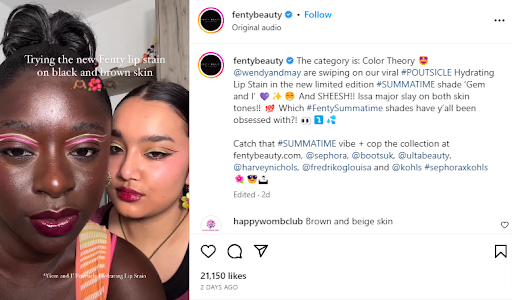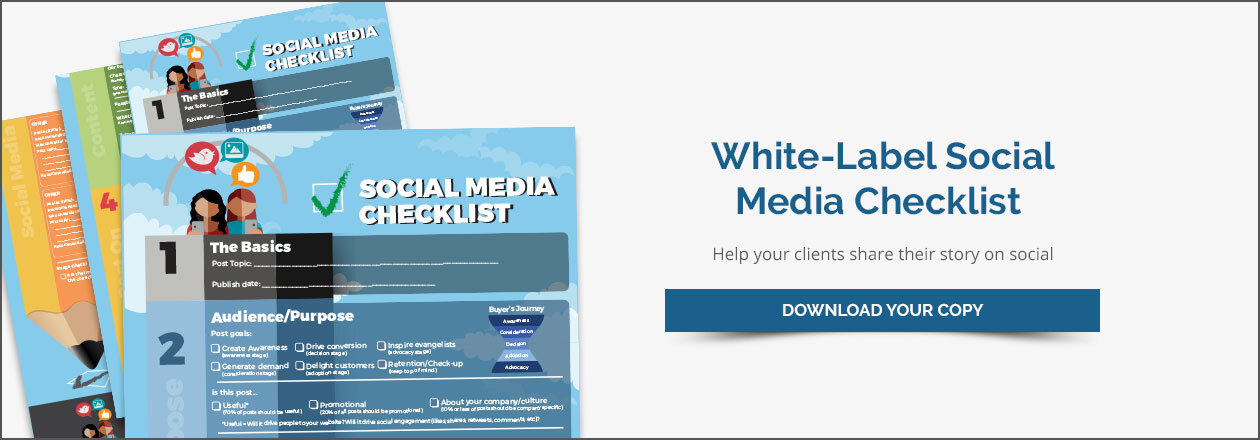A guide to mastering social media branding for your clients
Social media branding is at the very heart of social marketing. Turning a company or unknown person into an online presence that actually means something to social media users can mean the difference between a startup that flounders and a global influencer with untold commercial power.
Social media is an important communication channel. Ensure you create content that connects with your audience by downloading our free “White-label social media checklist” now.
This guide serves as a deep dive into the fascinating world of social media branding, including tips on building a brand persona, ideas for branding strategies, and lots of examples of companies already winning at the branding game.
Table of Contents
- What is social media branding and why is it important?
- How to build a strong social media branding strategy
- Social media branding guidelines you should implement
- Tips for creating a brand persona on social media
- How should you go about social media branding for small business clients?
- Social media branding trends to keep in mind
- Frequently asked questions
What is social media branding and why is it important?
Social media branding is defined as any persona that a company or individual creates to show the public. But the concept is so much bigger than simply choosing to highlight a few characteristics or drafting up a faux representative to serve as some kind of standing in.
Social media branding is about making connections through social media posts, marketing initiatives, and all those little interactions that result in even the smallest threads metaphorically typing consumers to an organization or business. Influencers are a great example of individualistic branding. For someone to go from a makeup artist to a makeup influencer, they must build out branding that:
- Highlights their values
- Shares specific messaging
- Resonates with viewers
- Is full of storytelling so memorable that people can’t help but continuously tune in
Social media’s impact on brand awareness and customer loyalty
Anchoring your branding on social media is kind of like building out a dating profile. For people to become attached to an organization or an individual, they must know enough about that organization or individual to decide whether there’s a connection. People in pursuit of a romantic attachment make their pitch by listing their hobbies, talking about their jobs and backgrounds, and letting their personality shine.
Branding for businesses isn’t all that different. Being open and showcasing the people, values, and activities that make up a company’s day-to-day operations and overarching ethos can help companies reach their top goals. According to experts, here’s what social marketers are trying to achieve with their online branding: (Sprout Social)
- Brand awareness (70%)
- Sales and lead generation (59%)
- Increase community engagement (48%)
- Grow my brand’s audience (46%)
- Increase web traffic (45%)
Social media branding’s influence on reputation management
There’s also the crucial role of social media in reputation management. Some 78% of consumers say they’re influenced by social media posts when debating a purchasing decision (ReputationX). Then there’s the 71% of consumers who’ve had positive interactions with a brand’s social media account and are more likely to recommend the brand to loved ones because of it. More than one-third of customers say they all trust brands that have an active, interactive presence — including with said customer — on social media.
By creating an eye-catching, memorable, and attractive presence on social media, companies can build and showcase a brand that increases the likelihood of purchases and other conversions. But these relationships can also come in handy when things go wrong. Brands that already have a loyal following may find it easier to recover if their reputation takes a hit — or so say the 63% of consumers willing to give the benefit of the doubt to socially responsible businesses hit by a crisis (Prowly).
Examples of brands successfully using social media for branding purposes
When it comes to social media branding, the proof really is in the pudding. These three brands have built empires off their social presence.
- Slack. This productivity platform pitches itself as a messaging app that facilitates business communication and teamwork, and their social feed corresponds to that vision very well. The company often posts links to relevant news articles, offers tips on how to work smart, and features lots of user-generated content that acts as proof of concept.
- Dove. Dove’s body positive and inclusivity-themed ads are nearly ubiquitous these days. Images of women of all shapes, sizes, skin colors, and ethnicities often appear on the skincare company’s social media pages, underscoring the brand’s empowerment-based campaigns, like 2020’s “Courage is Beautiful” drive and the “#NoDigitalDistortion” campaign that followed.
- GoPro. Unsurprisingly for a company dedicated to videography and photography, GoPro is all about helping consumers capture moments in real time. Scroll through GoPro’s social media profiles and you’ll see tons of user-generated content, lots of interaction between the brand and its followers, and plenty of tips and tricks on living life to the fullest — on camera, of course.
How to build a strong social media branding strategy
Social media branding strategies are the expert-created and executed plans that help companies and individuals share their core messaging. It’s the how, whereas the actual branding is the what. Having a game plan ensures that each brand’s presence is as clear and cohesive as possible — something that’s important when trying to foster trust and nurture relationships between corporations and consumers.
To build a robust, dynamic strategy, social media marketers typically try to hit this checklist:
- Commit to consistent messaging
- Always have a plan
- Engage with consumers in as many ways and as often as possible
- Incorporate user-generated content to show brand ideals in action
- Use key metrics and other analytical opportunities to see which efforts are resonating and which need to be tweaked
Tips for keeping your brand presence cohesive across multiple social media channels
Approximately 75% of consumers recognize a brand from its logo, while 60% look at visual style, 45% at brand color, and 25% look for the brand’s unique voice (SocialMediaToday). Here’s how to capitalize on that information, plus a few more tips to help strengthen overall branding.
- Choose a logo and color pallet and stick to it. You may have to adapt graphics to channel-specific requirements, but keep the same general imagery and color picks to make your brand easy to pick out in a crowded social arena.
- Put personality first. Whether a brand’s voice is quirky and offbeat or formal and factual, that tone should be embraced and kept consistent from channel to channel. Don’t be formal on Facebook and then use tons of slang and filters on TikTok. It can feel disingenuous and throw customers off.
- Be sure all posts go back to the core mission. Everything posted on a brand’s social profiles should be totally in sync with the person or company’s core messaging. Staying the course helps emphasize what’s important to the brand and to current and future clientele.
- Carry everything over to non-social channels. Social branding is a niche subject, but it’s not a totally standalone concept. Social branding efforts should carry over to websites, print collateral, email templates, and pretty much everything else put out by an entity to avoid confusion and drive home the ideas of brand strength and unity.
3 examples of successful social media branding strategies at work
Beef up your social media management skills by following these stellar examples of online branding.
- Glossier. By adopting the tagline “You look good,” makeup and skincare company Glossier has made consumer satisfaction and self-esteem a major part of its branding strategy. The company says their products are “inspired by real people and their routines,” and it regularly uses social media to crowdsource product ideas, attract high-profile influencers, and get feedback on new releases.
- BarkBox. “At BARK, we want to make dogs as happy as they make us. Because dogs and humans are better together.” That’s BarkBox’s website banner text. The brand followed through on that idea by using their social media platforms not to hard sell, but to create a community where people can laugh at silly dog videos and share pics of their pets.
- PlayStation. Between 2014 and 2019, PlayStation grew its social media following by 12 million people. That’s a growth rate of about 376%, and that doesn’t happen without having a solid branding strategy in place. The gaming giant has focused heavily on a memorable mix of content that delivers exciting gaming footage, highlights streaming events, and fuels the idea of community.
Social media branding guidelines you should implement
Using social media to promote and strengthen a brand requires experience, organization, and lots of intention. The best opening move marketers can make is to put together a social media branding kit that follows through on industry best practices yet remains grounded in consistency and authenticity.
Some core social media guidelines that can help construct an effective branding plan include:
1. Construct and review social media profiles with a keen eye.
All branded profiles and pages should look similar, be professionally built, and undergo regular reviews. This way, information is always on point and up to date. The company logo should appear on every profile, and basic details like telephone numbers, brick-and-mortar and email addresses, website URLs, and hours of operations should be included and double-checked for accuracy.
2. Build audience personas.
Who are you talking to? Without knowing the answer to that question, you can’t effectively communicate with your social media audience. Do your research to learn who your ideal customer is, and then tailor messaging to fit not only those personas but also the demographic shifts that occur from platform to platform.
3. Get down to the nitty-gritty with grammar.
Even the smallest details matter when it comes to consistency. Things like whether you use them or en dashes and the Oxford comma may come into play, as will the formats you use for times and dates and which app you use to shorten URLs.
4. Have rules around audience interaction.
As vital as it is to interact with social media followers frequently, it’s even more important that those interactions are professional and totally on brand. Decide how formal or casual you want your social media team to be — and this should be in line with the brand’s overall voice.
5. Set parameters around the “fun stuff.”
In addition to setting up social media guidelines about text-based interactions, make rules about things like using emojis, hashtags, GIFs, memes, and other visuals. Can team members use them when responding on social media? If so, how often? Are there themes or pop culture references that are out of bounds?
Tips for creating a brand persona on social media
What is a brand persona? Just like an audience persona paints a picture of an ideal customer, a brand persona depicts a company or individual as an entity consumers can fully grasp and understand. So many businesses and organizations remain nameless and faceless. That makes it difficult for consumers to get an idea of who they’re dealing with.
Creating a brand persona takes abstract facts and features and packages them in a way that helps people connect. One top social media branding tip is to create a brand persona and use that as your lodestone or the hub of your strategy wheel. Every spoke should come out of that hub, and every idea should be true to the persona.
Some other tips for developing a strong brand persona include:
- Pinpoint the core characteristics or traits of the brand’s personality, such as sincerity, wisdom, fun, sophistication, adventurousness, etc.
- Outline what role the brand plans to take in consumer’s lives — for instance, being a friend, a mentor, or a source of information.
- Write out a dossier of your brand persona, including details like the “person’s” name, age, location, background, employment info, hobbies, income, preferred platforms, and likes/dislikes.
- Be mindful about using the dossier to inform decisions without tiptoeing into caricature territory — actions should feel authentic to the brand and never like you’re trying to mimic a real person.
3 top social media branding examples that showcase brand persona
Check out these brands that have successfully created a compelling brand persona on social media:
- Wendy’s. This burger brand has positioned itself as a family-friendly chain for decades — so much so, there is literally a visible brand persona in the form of Dave and his red-headed daughter. That familial feeling carries over on to social media, with posts that talk about hugs and nugs in equal measure.
- Fenty Beauty. Rihanna is the inarguable face of her beauty company, but the brand persona goes beyond the songstress’s likeliness to include a bigger picture profile of the “everywoman.” The brand is big on inclusivity and casual, trendy language, as shown in tweets like this one.
- Cincinnati Zoo. For a zoo full of animals, it makes sense that the brand persona could take various furry and feathered forms. Posts often feature the animals that make the zoo so special, with facts and stories attached to further personalize the collection of creatures that call the CZ home.
How should you go about social media branding for small business clients?
Many SMBs face challenges when looking to establish or build upon their social media presence. Branding can be a tricky and time-consuming pursuit, which is why it’s often a good idea to consult with or hire third-party experts to assist in building a strategy that’ll work over the long term.
If you’re committed to DIY-ing your branding, use the tips from throughout this article to build a persona, craft a strategy, and measure results. Avoid guessing whether something is working and rely solely on data points to measure results. Be authentic, be consistent, and listen to your consumers. They’ll tell you when something doesn’t feel right, and they’ll be equally vocal — through comments, likes, and shares — when you do something they love.
Social media branding trends to keep in mind
While your social media branding strategy is a great starting point, how you implement all the elements of that strategy will depend on other factors, too. Knowing what’s trending on social media can help you dial in your approach even more by piggybacking on what’s hot — and avoiding what’s not.
Here are some social media branding trends from 2023 to use as starting points as you brainstorm ideas for social media posts:
- Community. Talking at consumers is out of style, while talking with your audience is all the rage. Start conversations and keep participating, either by responding in the comments or referencing consumer input in future posts. All in all, 90% of social media marketers say active online communities will play a big role in their social strategies in 2023 (HubSpot).
- Alternative communication options. Community chats, AI customer service bots, and good old DMs are all taking center stage as ways for consumers to reach out to brands through social media. Be sure whoever is manning those conversations (bots included) are familiar with branding guidelines.
- Social search. Consumers are using social media platforms to search for not only people (58%) but also specific brands (32%), ideas and inspiration (32%), and products and services to buy (31%) (HubSpot). Branding should evolve to match, with companies and influencers sharing the ideas, interesting content, and purchasing info consumers are looking for.
Frequently asked questions
What are some common mistakes to avoid when creating a social media branding strategy?
One of the biggest mistakes inexperienced social media marketing and branding experts make is trying to create and launch a branding strategy without creating a style guide first. Lay out the rules, and then everybody knows what standards they’re supposed to meet. It’s also important to create buyer personas and ensure there’s a balanced mix of automated tasks and human oversight.
How can I measure the effectiveness of my social media branding efforts?
The best way to gauge how effecting your social media branding efforts is to use built-in social media analytics to analyze key metrics. Data that shows how many follows, shares, likes, and clicks you’re getting will tell you how consumers view your branding strategy. Tracking these metrics can also help you sell social media packages, as you’ll be able to demonstrate the efficacy of your strategy and execution.





